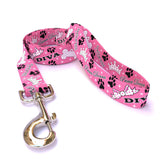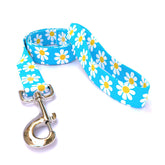What Types Of Dog Treats Are There? And Which is Best For My Dog?
Choosing the appropriate treat for your dog is seemingly a minor decision, yet it can help keep them healthy and happy. The best treats should be irresistibly yummy of course but also nutritious, appetizing, easy to digest and ideally should not contain ingredients that you yourself would not ingest (some exceptions apply). If your dog has a particularly sensitive stomach, your decision becomes slightly more complicated and you may consider giving treats with simple ingredients that have low-fat content.
So what exactly can treats be used for and what kinds are available?
Dog treats are the best way to give your dog a unique flavor to enjoy while supplementing their usual diet. Dog treats are traditionally used when training your dog as a motivating tool as they can encourage good behavior and entice your dog's curiosity. All while reinforcing the behavior the training is intended to promote. But if used properly, dog treats can also help a dog work out frustration and energy all while helping your pet develop good habits.
Ok great, now which treats do I choose?
A top concern for you is of course your dog's health and well being. If the treat you settle for is full of preservatives and junk and you would not eat it yourself, then do not feed it to your dog either. Here are some treats options available for the precious pets.
Crunchy Treats
Crunchy dog treats are available in a variety of sizes, flavors, and shapes. They include health bars, cookies, and biscuits. The size of the treat you buy for your dog should be appropriate for the dog. Choose one that meets the same standards as high-quality dog foods and one with ingredients of good quality. An example of a crunchy and all natural dog treat that is made in US is the Hot Dog Biscuit, seen here
Crunchy treats are often made from familiar ingredients such as crunchy peanuts and honey, yogurts and bananas, whitefish, sweet potato, potato protein, and chicken just to list a few. Ensure that the crunchy dog treats you choose does not contain artificial colors, flavors, preservatives, wheat or corn.
Soft Treats
Soft treats are chewy dog treats and are available in a range of flavors, sizes, and shapes. Soft treats are useful during training because they have a pleasant taste & textture, and are often made in very small sizes that are easy to carry around. They should be used in small quantities during training. Go for a brand that meets the similar standards with high-quality dog foods. An examples of soft dog treats are Zukes Mini Natural soft treats seen here. Look for soft dog treats that are wheat free, and those that contain a reasonable amount of proteins. And even some with healthy glycerin such as vegetable glycerin.
Freeze dried and jerky treats
Freeze-dried and jerky treats are appetizing and are similar to human food. They regularly come in the form of poultry, liver, seafood flavors, chicken, and beef. Most dog owners use them when training because of their unique and desirable flavor. The Zukes brand of Jerky treats are very popular with dogs of all shapes and sizes
Human Food Treats
Using human treats on your dog could be bad or good depending on what exactly you are using. Fresh foods such as apples, carrots, and limited amounts of certain seafood are beneficial to your dog. However, there are several foods that you should avoid which include crackers, cookies, hotdogs, cheese and junk foods. Avoid human food treats that contain sauces and seasoning. You should never give your dog onions and raisins as they are poisonous. Garlic should be used sparingly and only when directed by a veterinarian. Check out our free printout for food safety around your dogs, and keep them safe at your next party or event
Dental Chews and Bone-Like Treats
These treats are actually hard, yet digestible material such corn starch, sweet potato, glycerin, and are not made from animal bones or hides. Dental chews and bone-like treats are believed to promote dental health because of the degree of chewing required to consume them. Although they are safer than real bones, dogs must be supervised when given these treats because they can cause gastrointestinal blockage if inappropriate sizes are swallowed.
Pig Ears
Not to be confused with rawhides, these are actually made from ears of pigs. They are scrumptious to most dogs and are digestible. However they can be fatty and when processed with chemicals, pig ears can stain your flooring and furniture, and can even be unsafe. Pig ears should be avoided if your dog is at a risk of obesity.
Special Diet Treats
Treats for dogs on special diets are becoming more popular as dog allergies and even preferences are being diagnosed and recognized more often. These are often manufactured by the same food company that makes the regular food for a dog on a special diet. If not, your veterinarian should advise on an appropriate substitute.
Rawhide
One of the more controversial types of treats, they are also one of the most popular. Made from animal hide, rawhides are often treated with a variety of chemicals and can sometimes lead to gastrointestinal obstructions and other complications. However, given the volume of these consumed each year by dogs, the risks are still relatively low if you are careful in selecting the brand and type of rawhide. Be sure to check out our selection of US Made and treated hides here. Rawhide does promoted healthy gums and teeth, and can even help reduce anxiety and calm otherwise rambunctious dogs. As with any treat, but especially true with rawhides, you should always supervise your pet while using this product
Animal Bones and Hooves
Animal bones and hooves treats are not generally recommended, especially if cooked. They should be avoided since they can cause gastrointestinal blockage or perforation. They can also cause chipping or breaking of teeth. While raw bones can be given under a strict set of circumstances and supervision cooked bones and any kinds of poultry bones whether cooked or raw are never recommended. Consider giving your dog alternative digestible dental chews instead.
Homemade treats
Homemade dog treats can be healthier and save you a lot of money. Using items that you already have at home, you can whip up a tasty batch of homemade treats within a short time. They can also allow you to cater to specific dietary needs or restrictions of your dog. but of course, a home made treat is only as healthy as you make it, so be sure to use quality, healthy ingredients. And of course, make absolutely sure you know what types of foods are poisonous to your dog.
Sum It All Up
When looking for a suitable dog treat, you need to consider a brand that produces healthy and high-quality dog food. When it comes to nutrition, dogs just like people, need to be fed on healthy treats. Homemade treats have become very popular as they allow dog owners to prevent unhealthy additives. As a dog owner, you should make sure that your dog treats are stored in airtight containers to preserve their freshness and flavor. Treats can boost a healthy diet but should never make up over 10% of the daily food intake of the dog. We love our dogs and love seeing them happy and healthy, so be sure to carefully select the treats and chews for your furbabies!




